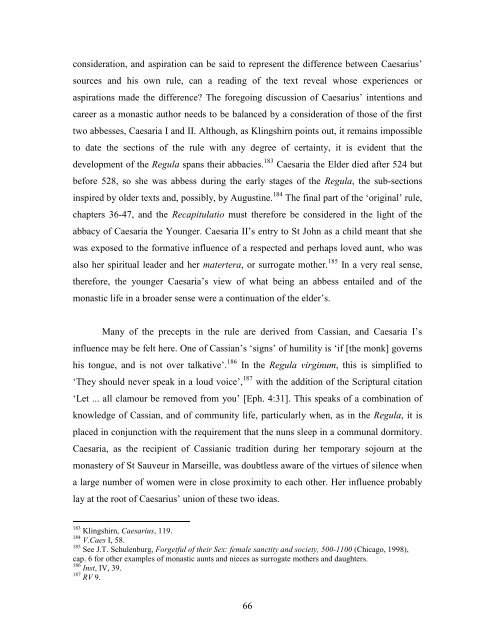Lindsay Rudge PhD Thesis - University of St Andrews
Lindsay Rudge PhD Thesis - University of St Andrews
Lindsay Rudge PhD Thesis - University of St Andrews
You also want an ePaper? Increase the reach of your titles
YUMPU automatically turns print PDFs into web optimized ePapers that Google loves.
consideration, and aspiration can be said to represent the difference between Caesarius’<br />
sources and his own rule, can a reading <strong>of</strong> the text reveal whose experiences or<br />
aspirations made the difference? The foregoing discussion <strong>of</strong> Caesarius’ intentions and<br />
career as a monastic author needs to be balanced by a consideration <strong>of</strong> those <strong>of</strong> the first<br />
two abbesses, Caesaria I and II. Although, as Klingshirn points out, it remains impossible<br />
to date the sections <strong>of</strong> the rule with any degree <strong>of</strong> certainty, it is evident that the<br />
development <strong>of</strong> the Regula spans their abbacies. 183 Caesaria the Elder died after 524 but<br />
before 528, so she was abbess during the early stages <strong>of</strong> the Regula, the sub-sections<br />
inspired by older texts and, possibly, by Augustine. 184 The final part <strong>of</strong> the ‘original’ rule,<br />
chapters 36-47, and the Recapitulatio must therefore be considered in the light <strong>of</strong> the<br />
abbacy <strong>of</strong> Caesaria the Younger. Caesaria II’s entry to <strong>St</strong> John as a child meant that she<br />
was exposed to the formative influence <strong>of</strong> a respected and perhaps loved aunt, who was<br />
also her spiritual leader and her matertera, or surrogate mother. 185 In a very real sense,<br />
therefore, the younger Caesaria’s view <strong>of</strong> what being an abbess entailed and <strong>of</strong> the<br />
monastic life in a broader sense were a continuation <strong>of</strong> the elder’s.<br />
Many <strong>of</strong> the precepts in the rule are derived from Cassian, and Caesaria I’s<br />
influence may be felt here. One <strong>of</strong> Cassian’s ‘signs’ <strong>of</strong> humility is ‘if [the monk] governs<br />
his tongue, and is not over talkative’. 186 In the Regula virginum, this is simplified to<br />
‘They should never speak in a loud voice’, 187 with the addition <strong>of</strong> the Scriptural citation<br />
‘Let ... all clamour be removed from you’ [Eph. 4:31]. This speaks <strong>of</strong> a combination <strong>of</strong><br />
knowledge <strong>of</strong> Cassian, and <strong>of</strong> community life, particularly when, as in the Regula, it is<br />
placed in conjunction with the requirement that the nuns sleep in a communal dormitory.<br />
Caesaria, as the recipient <strong>of</strong> Cassianic tradition during her temporary sojourn at the<br />
monastery <strong>of</strong> <strong>St</strong> Sauveur in Marseille, was doubtless aware <strong>of</strong> the virtues <strong>of</strong> silence when<br />
a large number <strong>of</strong> women were in close proximity to each other. Her influence probably<br />
lay at the root <strong>of</strong> Caesarius’ union <strong>of</strong> these two ideas.<br />
183 Klingshirn, Caesarius, 119.<br />
184 V.Caes I, 58.<br />
185 See J.T. Schulenburg, Forgetful <strong>of</strong> their Sex: female sanctity and society, 500-1100 (Chicago, 1998),<br />
cap. 6 for other examples <strong>of</strong> monastic aunts and nieces as surrogate mothers and daughters.<br />
186 Inst, IV, 39.<br />
187 RV 9.<br />
66

















